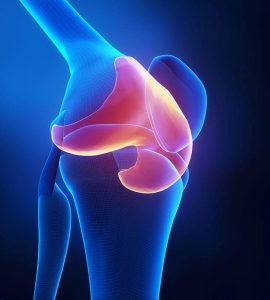Knee pain is one of the most common musculoskeletal complaints, affecting people of all ages and activity levels. It can appear suddenly after an injury or develop gradually due to wear and tear over time.
The knee is a complex joint that carries much of the body’s weight, and even minor issues can make walking, climbing stairs, or exercising difficult. Here are the top 5 common causes of knee pain to take note of.
1. Osteoarthritis
Osteoarthritis is the most frequent cause of chronic knee pain, especially in older adults. It is a degenerative joint disease that occurs when the cartilage that cushions the ends of the bones wears down over time. As the protective cartilage deteriorates, bones may rub against each other, causing pain, stiffness, and swelling.
Common symptoms of osteoarthritis include:
- Aching or throbbing pain that worsens with activity
- Morning stiffness or stiffness after long periods of sitting
- Swelling and decreased range of motion
- Occasional grinding or popping sensations in the knee
Risk factors include age, previous knee injuries, obesity, and family history. While osteoarthritis is not reversible, early diagnosis and management can slow its progression and improve quality of life.
2. Ligament Injuries
The knee relies on four major ligaments for stability: the anterior cruciate ligament (ACL), posterior cruciate ligament (PCL), medial collateral ligament (MCL), and lateral collateral ligament (LCL). Injuries to these ligaments often result from sports, falls, or sudden twisting movements.
- ACL injuries are especially common in athletes involved in soccer, basketball, and skiing.
- MCL injuries often result from impact to the outer side of the knee.
Typical signs of a ligament injury include:
- Sudden pain and swelling after an injury
- A popping sound at the time of injury (common in ACL tears)
- Knee instability or a feeling that the knee might give way
Diagnosis is usually confirmed with a physical exam and imaging such as MRI. Treatment can range from bracing and physiotherapy to surgical reconstruction, depending on the severity and patient activity level.
3. Meniscus Tears
The meniscus is a C-shaped piece of cartilage that cushions and stabilizes the knee joint. A sudden twist, squat, or pivoting movement can tear the meniscus, particularly during sports or heavy lifting.
Symptoms of a meniscus tear include:
- Localized pain and swelling within 24 to 48 hours of injury
- Stiffness and limited knee mobility
- Catching, locking, or clicking of the knee joint
Meniscus tears are diagnosed with physical examination and MRI imaging. Small tears may heal with rest, ice, compression, elevation (RICE), and physiotherapy. Larger or displaced tears may require arthroscopic surgery to repair or remove the damaged tissue.
4. Patellofemoral Pain Syndrome
Often referred to as “runner’s knee,” patellofemoral pain syndrome (PFPS) is a common cause of knee discomfort, particularly in young athletes and active individuals. It occurs when the kneecap (patella) does not track properly in its groove, leading to irritation of the surrounding tissues.
Symptoms include:
- Dull, aching pain in the front of the knee, especially when climbing stairs, squatting, or sitting for long periods
- Occasional popping or grinding sounds
- Discomfort during running or after increased activity
Contributing factors can include overuse, muscle imbalances, or poor footwear. Most cases respond to non-surgical management, including physiotherapy to strengthen the quadriceps and hip muscles, activity modification, and supportive shoes or orthotics.
5. Tendonitis
Tendonitis, also known as tendinitis, is the inflammation of tendons that connect muscles to bones. In the knee, the most common form is patellar tendonitis, often called “jumper’s knee,” which affects the tendon connecting the kneecap to the shinbone.
Typical symptoms of tendonitis include:
- Pain below or above the kneecap, especially during jumping or running
- Swelling and tenderness along the tendon
- Increased discomfort during physical activity or after prolonged use of the knee
Repetitive strain from sports like basketball, volleyball, or running can lead to tendon irritation. Treatment often involves rest, ice, anti-inflammatory medications, stretching, strengthening exercises, and, in some cases, physiotherapy. Chronic cases may require more advanced interventions such as shockwave therapy or injections.
Diagnosing and Treating Knee Pain
An orthopaedic specialist will begin with a thorough medical history and physical examination, followed by imaging tests like X-rays, MRI, or ultrasound to identify the exact cause of knee pain.
Treatment depends on the underlying condition but often includes a combination of:
- Activity modification and temporary rest
- Physiotherapy to improve strength and flexibility
- Bracing or orthotic support
- Anti-inflammatory medications or injections for pain relief
- Surgical intervention in cases of severe injury or advanced joint damage
Preventing Knee Pain
While not all knee pain is avoidable, you can reduce your risk with the following strategies:
- Maintain a healthy weight to reduce pressure on the joints
- Strengthen the muscles around the knee, especially the quadriceps and hamstrings
- Warm up before exercise and practice proper technique in sports
- Wear supportive footwear for your activity level
- Avoid sudden increases in activity intensity or duration
When to See an Orthopaedic Specialist
Persistent knee pain, swelling, or instability should not be ignored. Early evaluation and treatment can prevent minor issues from developing into long-term problems. If your knee pain is interfering with daily activities, waking you at night, or accompanied by sudden swelling after an injury, consult an orthopaedic specialist promptly.




